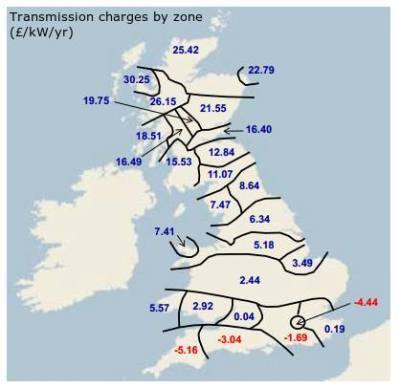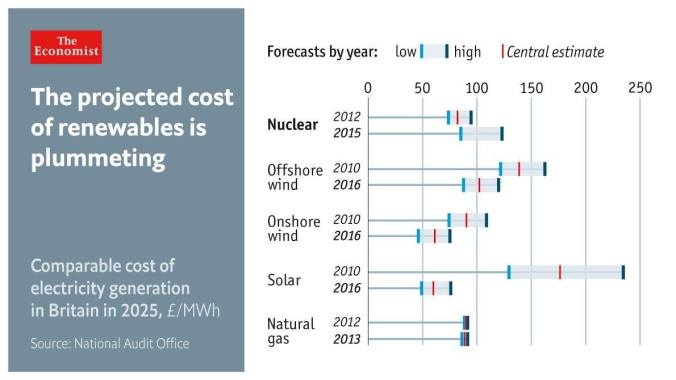“The measure of a man is what he does with power.” – Plato

5MW wind turbine under construction at Nigg Energy Park
The National Grid does not serve our nation.
The UK’s electricity network is not designed for the 21st century. It is certainly not designed to be able to best exploit the resources we will want to be using in the post-oil age.
The basic premise of the national grid is that until now we have run a centralised system with near-zero storage. Power is generated at a comparative few power stations and distributed to where it is needed.
To minimise infrastructure costs and transmission losses, this led to a system whereby the National Grid (the operator) levies charges for connecting to the national grid (the infrastructure) based, in principle, on distance from “population centres”.
Except what this actually means is distance from London. As shown below, if you want to connect a 1MW generator to the UK grid you’ll be paid over £5,000 per year to do so. Connect the same generator in Caithness and you’ll have to PAY £25,420 for the privilege.


Top: Regional map of National Grid Connection Tariffs for 2013/14.
Bottom: 2015/16 figures, Source: here.
Except that it’s not even simply a matter of “distance from London”. Connect your generator at Penzance, 412km from the centre of London and you’ll be paid £5.8 per kW/yr but connect it in Gretna, 435km from London, and you’ll be paying £13.37 per kW/yr.
What all this means is that any attempt by Scotland to contribute to the national grid is hampered from the beginning. The logic of the past, such that it was, was based on a system of centralised power generation where the fuel (coal and oil then later gas and uranium) could be transported to where the power could most efficiently be generated. This logic no longer applies to a future where the generators must go to where the wind, the tide, the water and the sun are. It also no longer applies to a future which will rely on many decentralised generators scaling from household sized rooftop solar panels out to massive offshore wind farms which have the potential to outstrip Scotland’s oil wealth many times over.
A 2009 study by the EU found that the unrestricted technical potential of Scottish offshore wind (that is, if Scotland built an offshore wind turbine everywhere it was technically feasible to build one regardless of cost, navigation disruption, visual disruption or any other factor) then we could expect to generate somewhere in the region of 4,000 TWh of energy per year. For reference, between 1973 and 2015, the UK has extracted an average of 1,637,690 barrels of oil per day from the North Sea and surrounds (The 2015 average was around half of this long term average). Each barrel of oil contains a chemical energy content of 1.7MWh (not all oil is burned as fuel but some 85% currently is) so this implies an annual energy equivalent extraction of just a little over 1,000 TWh. Our offshore wind potential is four times larger than our entire oil output.

 Add to this an potential of around 45 TWh per year worth of onshore wind, Anywhere between 5.5 TWh and 45 TWh per year from rooftop solar, 2.7 TWh per year from hydro, 16.5 TWh per year from tidal, 45 TWh per year from wave, 7.6 TWH per year from geothermal and perhaps another 7 TWh from other sources such as biomass.
Add to this an potential of around 45 TWh per year worth of onshore wind, Anywhere between 5.5 TWh and 45 TWh per year from rooftop solar, 2.7 TWh per year from hydro, 16.5 TWh per year from tidal, 45 TWh per year from wave, 7.6 TWH per year from geothermal and perhaps another 7 TWh from other sources such as biomass.
Even excluding the vast offshore wind reserves, this all adds up to around at least 130 TWh per year which just in and of itself almost meets the 2013 total Scottish energy demand of 144 TWh which itself excludes further savings which could come by reducing our demand for things like heat for our homes (theoretical reductions of up to 60 TWh per year if every building in Scotland was replaced with a passively heated one) or other initiatives such as capturing and harnessing waste heat from our industries (a potential source of up to 35 TWh per year)
So in terms of sheer capacity, Scotland is bathed in potential, far more than we could reasonably use and perhaps even far more than we could reasonably export (The total energy use of the entire EU is somewhere in the region of 12,000 TWh per year).
Which brings us back to the national grid.
If Scotland were to transfigure to a completely renewable electric society, as the Scottish Government clearly wants to be able to do, and was to connect the required 144 TWh worth of electricity to the UK grid then at current fees it would cost us some £333 million per year (which would be added to our utility bills). As stated at the beginning, we can’t move the wind and sun to the generators the way we could coal and gas so Scotland is quite simply being discriminated against by this charging regime.
In fact, let’s take a moment to dispel something. This idea of there being one national electrical distribution grid stretching right across the UK and that Scotland would need to do some drastic upgrading in the event of independence was one of the Great Unchallenged Lies of the 2014 No campaign. There isn’t one distribution grid across the UK. There isn’t even one across the island of Great Britain. There isn’t even one electrical distribution grid covering all of Scotland!
The UK Electricity Distribution (local and regional grids) and Transmission (high voltage, long range) grids. Source here.
The first step towards realising our renewable potential will lie in taking back control of the grids in Scotland. The situation of our being economically penalised by the grid connection fees as well as the lack of ability to take this chance to reconfigure our grid from the 19th century mass generation model to one fit for the 21st century largely stems from our willingness to leave ownership and responsibility for the running of our electrical supply to “the market”. The UK is just about the only country in Europe which doesn’t contemplate state ownership of its own electrical infrastructure (except, of course, if it’s not OUR state doing the owning. Having France and China build our power stations is just fine).
A few years ago, Common Weal published a paper on the potential for Scotland to take back control of our infrastructure (it wouldn’t cost us any more to do so than it does to leave it where it is) as well as the potential for using national borrowing to finance the expansion using cheap government bonds which are far lower than commercial bank rates and tiny compared to the return on investment on wind and solar projects.
And cost will be a major factor in this transition (that is, what it will cost us if we don’t make that transition.
If you had asked someone five years ago the question “In 2025, what will be the three cheapest ways to make electricity” they would have answered “onshore wind, natural gas and nuclear”. You would have then been reasonably well founded in building a policy based on new nuclear plants and fracking, assuming you were fine with continuing to ignore the climate, pollution and other economic issues.

Ask the question again today and your top three would be “onshore wind, solar and offshore wind”. Anyone still backing Ineos, the Atlantic Margin or Hinkley Point C as the saviours of our energy supply have already lost that argument to sheer economics before any of those projects even begin.
So we’ve fixed generation and we’ve fixed the infrastructure, we can just go ahead and start the conversion, can’t we?
Not quite. The raw numbers are suggestive but there are still a couple of problems to be tackled in a 100% renewable Scotland. Part 2 will show what it looks like to move to more intermittent energy sources than we’re used to and what role energy storage can play in all of this.


The idea of levying the generators to connect based on the distance from population centres (with some anomalies) makes sense when the product is abundant. In this case coal and oil fired power stations. They have to compete for customers. However when the product is scarce the argument is turned on its head, the consumer now needs to be paying based on their distance from the generator. This is basic free markets in action. Problem is we have corrupted markets that are not free from monopolists.
So the person/business in London would now have to pay the infrastructure cost to get electricity sent from Scotland or elsewhere. Could be a substantial amount.
LikeLiked by 1 person
As I say, the logic of the grid is there. If you want to minimise transmission losses and you can move the fuel around efficiently (by train or pipeline or whatever) then you’d design the grid as it has been. It’s just that the paradigm has changed and that logic no longer applies.
LikeLike
You’re absolutely correct about the transmission charges for connecting Scotland to London being crippling. The interconnect is designed to facilitate an international energy market, although as you point out the pricing structure doesn’t do that because the transmission charges are stacked against transmission from Scotland to England. But there’s also another way of thinking about this.
The interconnect even with its prohibitive levies on power from Scotland still pushes up the price of electricity here because of the market for it down south. However we could aim to keep the electricity in Scotland and use it to attract energy users here. This would be more efficient in energy terms as it would reduce transmission losses as well as making economic sense. Not only would it save paying the transmission charge it would generate income and jobs for Scotland plc. It’s happened in the past to some extent with the old hydro schemes e.g Alcan aluminium smelters at Fort William and Kinlochleven.
If we closed down the interconnect to England today we would risk the lights going out on low wind, high energy use days, but it doesn’t have to be like that. If we invest in energy storage and smart grids which can drop some loads at peak times (e.g domestic freezers would be OK for an hour or so with no power at peak times) we could remove some of that instability. If we closed the interconnect once we have energy storage in Scotland there would be an electricity surplus which would push down prices and encourage energy users to locate here. In reality we probably wouldn’t want to close down the interconnect completely as having a widespread grid does help to make electricity supply more stable
Of course we don’t have control of energy policy in Scotland, so there is little which the Scottish Government can do about transmission charges (other than complain to a UK Government which doesn’t care). It also can’t regulate or nationalise the energy market, so it is severely limited in what it can do to ensure that Scotland benefits from the energy it generates by being able to access it more cheaply than rUK. However it might have some levers via business and enterprise policy which it could use to attract energy intensive industries to locate here, but it would be much better to have full control over Energy Policy in Scotland.
LikeLike
Looks like Scotland could have a huge surplus of energy, so it seems crazy that we can’t have cheaper bills here, especially as wind power is reducing all the time, and floating turbine technology is progressing.
Surely a national energy company would be a massive selling point for a future referendum. Energy should be one of our biggest assets.
It seems strange that it wasn’t much of a campaign tactic in 2014. Jim Sillars was slammed for that ‘day of reckoning speech’, but a degree of nationalisation should maybe have been part of a well defined policy.
LikeLiked by 1 person
Pingback: Renewing Scotland: Part 1 – Harnessing Potential | The Common Green
Pingback: The Common Green’s 2016 Retrospective | The Common Green
I note dryly that the site of the great big humungus white elephant of a French Chinese Nuclear generator at Hinkly Point has a pay in positive discount. Another we hidden subsidy to keep London the cheapest plane for electricity. The decommission costs are built into the kw prices allowed to generator so after its life the operator effectively walks away, if they have husbanded the extra cash and nor gone bust before?
That plant design has never worked before and contriction attempts of the design are years in delay already.
The other two Toshiba designed reactors look as though will never be built as Toshiba is bust
LikeLike
Pingback: My Democratic Dilemma | The Common Green
Pingback: Grim Drama Parked | The Common Green
Well, it certainly points out the potential Scotland has, and it is only one area. The problem of energy storage is a worldwide one, and many companies across the globe are trying to solve it.
It will happen in the near future, as these companies see the need and potential for the good storage
within the industry and beyond.
Once a good solution is found, the future developments will see changes across the world, as the enviroment issues will be too big to ignore, along with their profits.
LikeLike
Pingback: Wings Over Scotland | The boom blockers